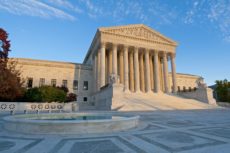Term Limits for Supreme Court Justices?
 Article III, Section 1 of the U.S. Constitution provides that “Judges, both of the supreme and inferior Courts, shall hold their Offices during good Behaviour …” The result is that instead of choosing Justices on the basis of their experience, maturity and gravitas, there is a premium on packing the Court with youngsters who will reflect the incumbent administration’s values for as many decades as possible.
Article III, Section 1 of the U.S. Constitution provides that “Judges, both of the supreme and inferior Courts, shall hold their Offices during good Behaviour …” The result is that instead of choosing Justices on the basis of their experience, maturity and gravitas, there is a premium on packing the Court with youngsters who will reflect the incumbent administration’s values for as many decades as possible.
The current Supreme Court, consisting of Justices Kennedy, Thomas, Ginsburg, Breyer, Roberts, Alito, Sotomayor, and Kagan (in order of confirmation), were confirmed at ages 51, 43, 58, 45, 40, 55, 55, and 50, respectively. They have served for 28, 25, 23, 22, 11, 11, 7, and 6 years. The late Justice Antonin Scalia was confirmed at age 50 and served 29 years. President Trump’s new nominee, Neil Gorsuch, is 49. There have been no successful nominees in recent memory over 60, and only one over 55.
A 14-year term limit would make the optimal age for a new Supreme Court Justice about 60. Most retirements would arrive on a predictable schedule with Justices in their mid-70s, rather than on an undignified death watch as at present. So far we’ve been spared (to the best of my knowledge) the predicament of a Justice afflicted by Alzheimer’s disease, a debilitating stroke, or senile misbehaviour, but as life expectancy increases, this is merely a matter of time.
A study by David Garrow documents that no less than 17 Justices became incompetent by virtue of “mentally decrepitude,” yet continued to serve and sometimes even cast decisive votes. A few notable 20th century instances were Justices Taft, Holmes, Black, Douglas, Powell, Brennan, and Marshall. At present the only remedy for such a condition is impeachment by Congress, but unfortunately that would cast an undeserved moral shadow over the Justice in question. Term limits would greatly reduce the probability and consequences of such a misfortune. With such a limit, the continuity of Supreme Court decisions would be determined by the strength of their legal reasoning, rather than by the longevity of their proponents as at present. [Paragraph corrected 6/24/17. See comment below for reference.]
The optimal age for new inferior court judges would be considerably lower. Capable youthful candidates would not be deterred by the term limit, because they would view the position as a stepping stone to a higher federal court, or even the Supreme Court. The 14-year clock would of course reset on each new appointment. Any constitutional amendment imposing such a term limit should grandparent-in incumbent justices to avoid politicizing the amendment process.
Many reformers have advocated term limits for members of Congress as a panacea for all (or at least much) that ails Washington. However, Representatives and Senators already have 2- and 6-year term limits, at the end of which they must face re-election, so that I am unexcited that artificially limiting their total service would make Congress more responsive to changes in public opinion. Redistricting reforms would be a much better way to ensure periodic blasts of new blood in Congress. [See my forthcoming June 21 blog post here, “Crowdsourced Redistricting”] I must admit, however, that I do find the 8-year limit on Presidents to be refreshing.
Disclaimer: The author is not an attorney, but an economist.





